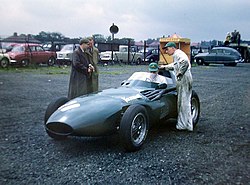| 1957 British Grand Prix | |||||
|---|---|---|---|---|---|
| |||||
 | |||||
| Race details | |||||
| Date | 20 July 1957 | ||||
| Official name | Grand Prix d'Europe incorporating the 10th RAC British Grand Prix | ||||
| Location | Aintree Circuit, Liverpool, England | ||||
| Course | Permanent racing facility | ||||
| Course length | 4.828 km (3.000 miles) | ||||
| Distance | 90 laps, 434.52 km (270.00 miles) | ||||
| Weather | Overcast, dry. | ||||
| Pole position | |||||
| Driver | Vanwall | ||||
| Time | 2:00.2 | ||||
| Fastest lap | |||||
| Driver | | Vanwall | |||
| Time | 1:59.2 | ||||
| Podium | |||||
| First | Vanwall | ||||
| Second | Ferrari | ||||
| Third | Ferrari | ||||
Lap leaders | |||||


The 1957 British Grand Prix was a Formula One motor race held on 20 July 1957 at the Aintree Circuit, near Liverpool. It was the tenth British Grand Prix and it was race 5 of 8 in the 1957 World Championship of Drivers. The race was won by Stirling Moss and Tony Brooks, who shared driving duties in a Vanwall. It was the third and final time that a Grand Prix had been won by two drivers in a shared car. This was the first occasion that a British constructor won a World Drivers' Championship race, a feat achieved with two British drivers at their home Grand Prix.
